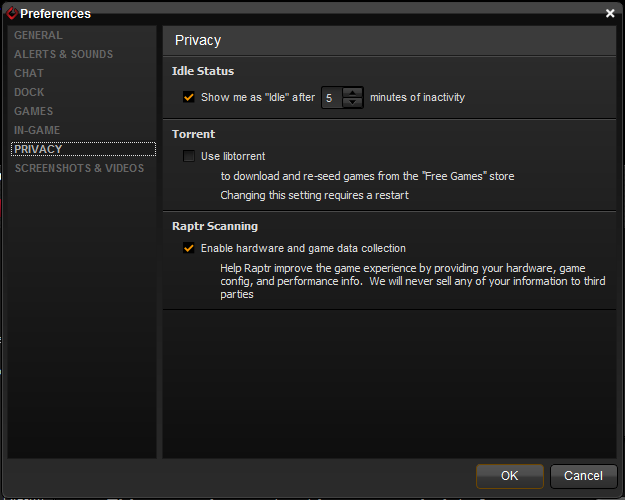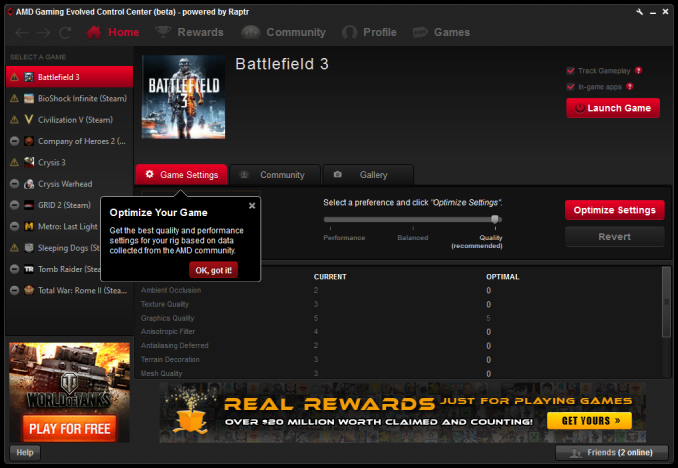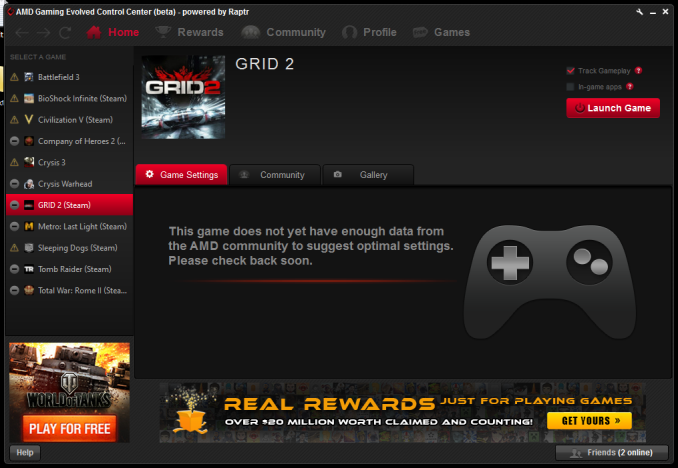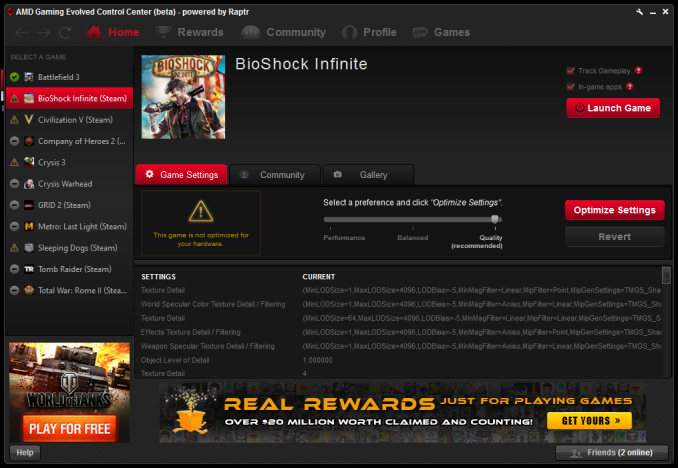The AMD Radeon R9 290 Review
by Ryan Smith on November 5, 2013 12:01 AM EST- Posted in
- GPUs
- AMD
- Radeon
- Hawaii
- Radeon 200
AMD's Gaming Evolved Application
During AMD’s “partner time” block at the 2014 GPU Product Showcase, one of the projects presented was the Raptr social networking and instant messaging application. Put together by the company of the same name, AMD would be partnering with Raptr to produce an AMD branded version of the utility called the “AMD Gaming Evolved App, Powered By Raptr”.
In a nutshell, the Gaming Evolved App (GEA) is AMD’s attempt to bring another value add feature to the Radeon brand. And although AMD will never explicitly say this, to be more specific the GEA is clearly intended to counter NVIDIA successful GeForce Experience utility, which exited beta back in May and has been continuing to add features since.
Raptr/GEA contains a wealth of functionality, with the application being several years old at this point, but the key feature as a video card utility and the reason AMD has picked it up is its latest feature addition, the game optimization service. Just launched last month in beta, the optimization service is a functional clone of GeForce Experience’s optimization service. Designed with the same goals in mind, the GEA optimization service is intended to offer the ability for gamers disinterested in configuring their games – or even just looking for a place to start – a way to simply download a suitable collection of settings for their games and hardware and apply those settings to their games.
The concept is in practice very similar to the recommended settings that most games apply today, but driven by the GPU manufacturer instead of the game developer, and kept up to date with hardware/software changes as opposed to being set in stone when the game went gold. Even for someone like a professional GPU reviewer, it’s a very nifty thing to have when turning up every setting isn’t going to be practical.
To get right to the point then, while we’re big fans of the concept it’s clear that this is a case of AMD tripping over themselves in trying to react to something NVIDIA has done, by trying to find the fastest way of achieving the same thing. Like GeForce Experience, AMD has started bundling GEA with their drivers and installing it by default, but unlike GFE it’s still in beta at this point, and a very rough beta at that. And not to take an unnecessary shot at AMD, but even in beta GeForce Experience wasn’t this raw or this incomplete.
So why are we so down on GEA? There are a few reasons, but the most basic of which is that the Raptr service lacks enough performance data for GEA to offer meaningful recommendations. Even on a fairly old card like a Radeon HD 7950, GEA was only able to find settings for 5 of the 11 games we have installed on our GPU testbed, failing to include settings for a number of games that are months (if not years) old. To be fair every service has to start out somewhere, and GFE certainly didn’t launch with a massive library of games, but 5 games, none newer than March, is a particularly bad showing.
Now a lot of this has to do with how Raptr collects the performance data it uses for recommendations. NVIDIA for their part decided to do everything in house, relying on their driver validation GPU farms to benchmark games across multiple settings to find a good balance based on parameters picked by the GFE development team. Raptr, though backed by AMD, does not have anything resembling NVIDIA’s GPU farms and as such is going the crowdsourced route, relying on telemetry taken from Raptr users’ computers. Raptr’s data acquisition method is not necessarily wrong, but it means there’s no one to bootstrap the service with data, which means the service has started out with essentially nothing.

Raptr for their part is aware of the problem they’re faced with, and in time the distribution of the GEA along with their own Raptr application will hopefully ensure that there are enough users playing enough games out there to collect the necessary data. Even so, they did have to implement what amounts to a solution to the tragedy of the commons problem to make sure that data gets collected; users cannot receive settings from the Raptr service unless they provide data in return. Turning off the telemetry service will also turn off the client’s ability to pull down settings, full stop. Given the service’s requirements for data collection it’s likely the best solution to the problem, but regardless we have to point out that Ratpr is alone in this requirement. NVIDIA can offer GFE without requiring performance telemetry from users.
Moving on then, the other showstopper with GEA’s current optimization service is that it’s obvious the UI has been an afterthought. The GEA UI lists settings by the values used in a game’s settings file, rather than the name of that value. E.g. “Ultra” texture quality in Bioshock Infinite is labeled as texture detail “4”, or worse. Without sufficient labeling it’s impossible to tell just what those settings mean, let alone what they may do. As such applying GEA settings right now is something of a shot in the dark, as you don’t know what you’re going to get.
Finally, presumably as a holdover from the fact that Raptr is free, GEA runs what can only be described as ads. These aren’t straight up advertisements, rather directing users towards other services Raptr/GEA provides, such as Free-2-Play games and a rewards service. But the end game is the same as these services are paid for by Raptr’s sponsors and are intended to drive users towards purchasing games and merchandise from those sponsors. Which far be it for us to look down upon advertisements – after all, AnandTech is ad supported – but there’s something to be said for ad supported applications in a driver download. We're at something of a loss for explaining why AMD doesn't just foot the complete bill on their customized version of the Raptr client and have the ads removed entirely.
At any rate we do have some faith that in time these issues can be dealt with and the GEA can essentially be fixed, but right now the GEA is far too raw for distribution. It needs to go back into development for another few months or so (and the service bootstrapped with many more computer configurations and games) before it’s going to be of suitable quality for inclusion in AMD’s drivers. Otherwise AMD is doing their users a disservice by distributing inferior, ad supported software alongside the software required to use their products.
The Test
For the launch of the Radeon R9 290, the press drivers and the launch drivers will be AMD’s recently released Catalyst 13.11 Beta v8 drivers. Along with containing support for the 290 and the 47% fan speed override, the only other changes in these drivers involve Batman: Arkham Origins and Battlefield 4, games which we aren’t using for this review. So the results will be consistent with past drivers. Meanwhile for NVIDIA’s cards we’re continuing to use their release 331.58 drivers.
| CPU: | Intel Core i7-4960X @ 4.2GHz |
| Motherboard: | ASRock Fatal1ty X79 Professional |
| Power Supply: | Corsair AX1200i |
| Hard Disk: | Samsung SSD 840 EVO (750GB) |
| Memory: | G.Skill RipjawZ DDR3-1866 4 x 8GB (9-10-9-26) |
| Case: | NZXT Phantom 630 Windowed Edition |
| Monitor: | Asus PQ321 |
| Video Cards: |
AMD Radeon R9 290X AMD Radeon R9 290 XFX Radeon R9 280X Double Dissipation AMD Radeon HD 7970 GHz Edition AMD Radeon HD 7970 AMD Radeon HD 6970 AMD Radeon HD 5870 NVIDIA GeForce GTX Titan NVIDIA GeForce GTX 780 NVIDIA GeForce GTX 770 |
| Video Drivers: |
NVIDIA Release 331.58 AMD Catalyst 13.11 Beta v1 AMD Catalyst 13.11 Beta v5 AMD Catalyst 13.11 Beta v8 |
| OS: | Windows 8.1 Pro |













295 Comments
View All Comments
HisDivineOrder - Tuesday, November 5, 2013 - link
I don't think you get how loud they're saying this card is, but go on, buy it. I think you'll figure it out pretty quick.JDG1980 - Tuesday, November 5, 2013 - link
That will be completely irrelevant in a couple of weeks when aftermarket designs become available. The reference cards are pretty much for water block users only.nathanddrews - Tuesday, November 5, 2013 - link
I get it that being quiet is a nice feature... but it's way at the bottom of my list. I want the most frames for the dollar followed by thermals and then power usage. Then, way under that, I care about acoustics. The article sure fusses a lot given that AMD very rarely makes quiet coolers. The aftermarket cards will all sport more efficient dual/triple fan setups... or silent water blocks...hoboville - Tuesday, November 5, 2013 - link
Basically this, if 3rd parties make custom PCBs with custom VRMs, you probably won't be able to affix a waterblock, because they are usually built for reference designs.To the guy who says "he's focusing too much on noise" has no idea what a fan at 60 DB sounds like. Basically, take an industrial fan, and point it at your face, and turn it on medium. Or, drive with your windows down at 45 MPH. It's distracting.
HisDivineOrder - Tuesday, November 5, 2013 - link
Exactly.nathanddrews - Tuesday, November 5, 2013 - link
I don't know about you, but I have my PC under my desk about 4-6 feet from my face. I think AT measures decibels at 12 inches. Even if they measure from 24 inches, that's a HUGE difference in perceived noise in real life. Between deflection, pitch, and attenuation, these decibel measurements are a waste of time in many applications. It's good to have objective data to compare, but unless your PC is sitting right up on your desk next to your monitor about the same distance from your face would it be distracting... and only under load... assuming there were no other sounds coming from your speakers (silent gaming?).Come to think of it, my HTPC is stored in an AV closet (totally silent) and my other HTPCs are hidden away and not audible. This card is amazing despite its SPL.
Galidou - Tuesday, November 5, 2013 - link
Wait for the new custom coolers, improved fps with upcoming drivers like any new products that takes time to adjust. Another comment about a crappy AMD cooler, like if anyone of us didn't know it's crappy, you had to fanboy comment about how crappy it is, I ALREADY got it from reading the review thanks!''Basically, take an industrial fan, and point it at your face, and turn it on medium. Or, drive with your windows down at 45 MPH. It's distracting. ''
Drive your 100k$ car right in a wall, destroy it, it's annoying. Everyone knows that, how obvious life can be sometimes. Another comparison that sounds as stupid as can be. PS I was sarcastic about the car, don't do it... while the guy above thought he was serious... OMG
Wait for aftermarket coolers, Nvidia got amazing launch results cauz they have very good coolers, this is already AMAZING and that's with the WORST cooler EVER, 2 weeks from now everyone will be in exctasy with the superb Asus DCU II or other amazing silent solution that will allow for overclocking.
Mirshaan - Friday, May 16, 2014 - link
BS. It's not that loud. 60db is normal conversation levels. HARDLY the sound of an industrial fan blowing in your face, or windows down at 45mph.... and that is coming from several sources online....http://www.gcaudio.com/resources/howtos/loudness.h...
http://airportnoiselaw.org/dblevels.html
https://www.chem.purdue.edu/chemsafety/Training/PP...
DMCalloway - Tuesday, November 5, 2013 - link
The only problem I can see at this point is that these aftermarket solutions are usually open designs...... this is going to result in a LOT of heat being pumped into the case.Galidou - Tuesday, November 5, 2013 - link
With a good aftermarket cooler, this doesn't dissipate more than 1-2 degree celsius than a GTX 780 while being superior, I don't see too much of a problem.